Landscaping Under Pine Trees: 31 Plants That Thrive Under Pine Trees
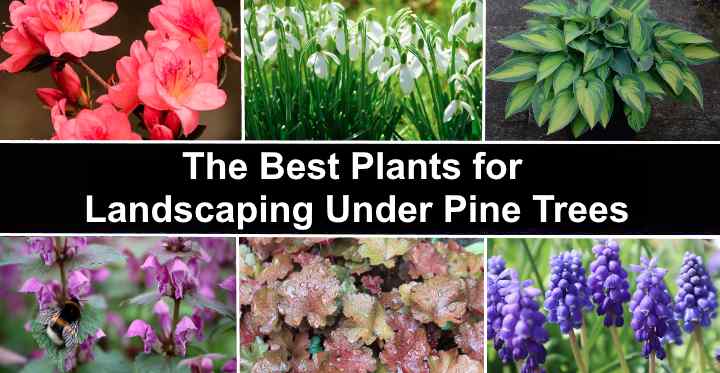
Finding the right plants for landscaping under pine trees can be challenging. Pine trees have shallow roots and thrive in sandy, well-drained soils where many shrubs, bulbs, perennial flowers, and ground cover plants struggle. Also, pine tree canopies create shaded areas, making it difficult to find plants that thrive in the soil conditions pine trees create.
The good news is that plenty of plants thrive under pine trees. Many varieties of bulbous plants, ferns, and perennials tolerate dry, acidic soil and dappled sunlight or full shade. These understory plants for planting in pine tree settings help to add color, beauty, and texture to garden landscapes.
Do Pine Needles Affect Soil Acidity?
One common belief is that pine needles significantly alter the soil pH, creating excessive acidity that prevents the growth of other plants. However, this idea is not entirely accurate. According to gardening experts, pine needles themselves have a moderately acidic pH, ranging from 3.2 to 3.8 when they fall from the tree. They can slightly increase the soil’s acidity if incorporated into it.
However, when pine needles are left on the soil, they decompose slowly. This gradual process allows the natural microbial activity in the soil to neutralize their acidity over time. The breakdown of needles eventually enriches the soil with nutrients, making them an effective mulching material for retaining moisture and suppressing weeds.
The Challenges of Planting Under Pine Trees
The challenging conditions for plants under pine trees arise due to the shallow and numerous root systems that compete for water and nutrients, making it difficult for other plants to establish themselves. Additionally, the dense, dry shade cast by pine trees presents an additional challenge for plants that require direct sunlight to thrive. While many plants can grow near pine trees, it is more challenging to find plants that can survive directly beneath them in constant shade.
It is important to consider that pine trees (conifers) naturally prefer acidic soil. Therefore, it is advisable to choose plants that can thrive in such soil when planting around pine trees.
Choosing the Right Plants for Planting Under Pine Trees
For successful planting under pine trees, it is crucial to select plants that can adapt to the dry shade conditions beneath them. These plants should also be able to tolerate acidic soil and flourish in both shade and drought.
Despite the challenges posed by pine trees, there are still various suitable options, such as certain flowers, ferns, and sedges that can thrive under these conditions. Understanding the specific requirements of these plants and the ecological dynamics of pine trees can help create a harmonious and flourishing garden environment.
This article explores some of the best pine-friendly plant options. The list is divided into the best bulbs, ferns, perennials, and ground cover plants to grow successfully around pine trees.
How to Prepare the Planting Area Under Pine Trees
Before planting bulbs, perennials, or shrubs under pine trees, remove weeds or grass using a hand trowel. Trying to dig out the weeds risks damaging the tree’s shallow roots. Also, don’t build up soil under the pine tree or around its flare because it may lead to potential issues and damage the tree.
Best Bulbs to Plant Under Pine Trees
Planting bulbs beneath pine trees adds color and vibrancy to the shaded ground, creating a beautiful, low-maintenance garden. Their early spring blooms complement the evergreen pine canopy.
Snowdrops (Galanthus)
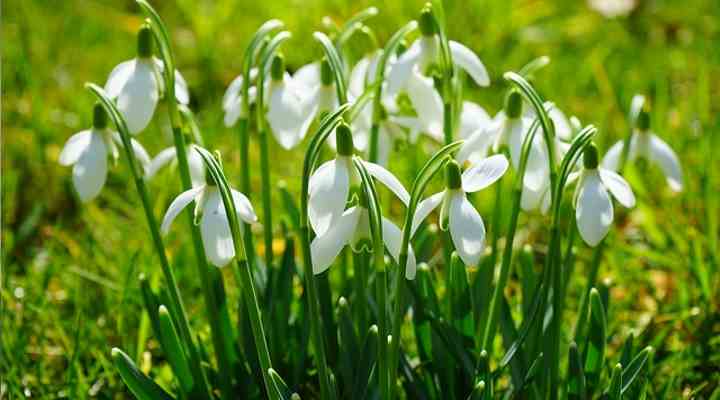
Snowdrops (Galanthus nivalis)
Snowdrops are the easiest bulbous plants to grow around pine trees. The delicate white flowers bloom in late winter or early spring. Snowdrop flowers are identified by the drooping bell-shaped blooms nodding among strap-like green leaves. Snowdrops thrive in most soil types and tolerate partial shade of pine tree’s dense canopy.
Snowdrops are ideal for planting close to pine trees, as the bulbs should be 2” (5 cm) below the soil surface. When they bloom in early spring, snowdrops grow up to 10” (15 – 25 cm) tall. They are known for their resilience and cold hardiness, growing in clumps in woodland gardens under evergreen trees.
- USDA Planting Zone: 3 to 8
- Sun Exposure: Partial shade to full shade
- Blooming Season: Late winter or early spring
- Mature Size: 4” to 10” inches (10 – 25 cm) tall
- Growth Rate: Double in size every two years
‘Vanguard’ Crocus (Crocus vernus ‘Vanguard’)
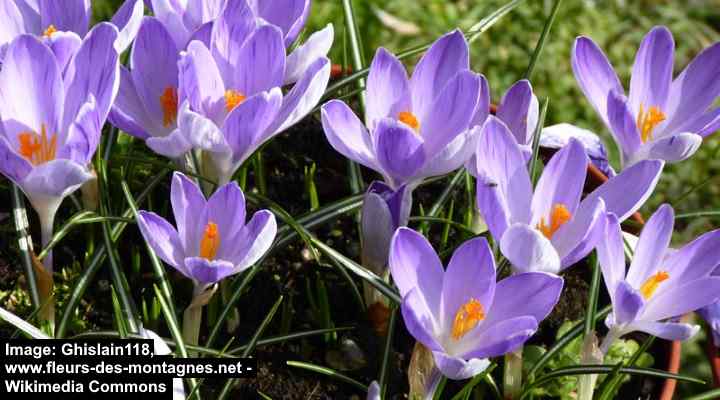
‘Vanguard’ crocus is a popular variety of flower known for its late winter or early spring bluish-lilac blooms. The beautiful purple flowers bring a splash of color to pine woodlands. The large, cup-shaped pale purple flowers contrast with dark green, narrow, lance-shaped leaves. Ideal for understory planting, the crocuses thrive in partial shade.
Also called Dutch crocus, the clumping flowering plant grows up to 6” (15 cm) tall. These vigorous bulbs bloom year after year and spread through underground tubers called cormlets. They are ideal for understory planting near pines because they naturalize easily and tolerate sun and shade. They also have minimal nutrient needs.
- USDA Planting Zone: 3 to 8
- Sun Exposure: Partial shade to full sun
- Blooming Season: Early spring
- Mature Size: 4” to 6” (10 – 15 cm) tall
- Growth Rate: Spread vigorously, forming clumps over time
Grape Hyacinth (Muscari armeniacum)
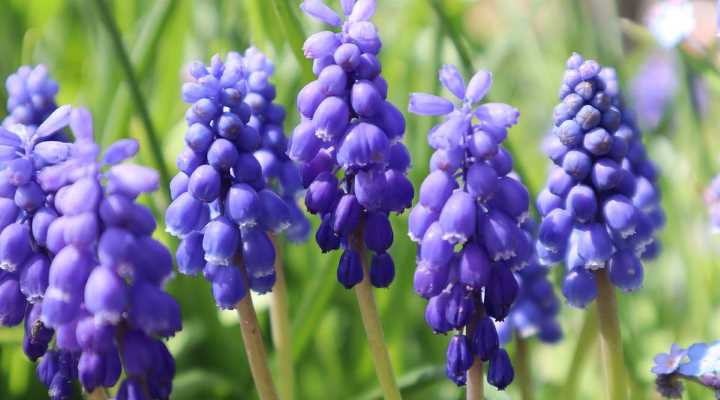
Grape Hyacinth (Muscari armeniacum)
Grape hyacinth is a beautiful, easy-to-grow bulbous plant that performs well under backyard pine trees. Blooming for several weeks in mid-spring, the deep purple-blue bell-shaped flowers are densely packed, cylindrical floral spikes resembling miniature grapes. The bulbous plant’s leaves grow in tufts and have a glossy appearance.
Grape hyacinths are a pine-friendly plant option because they tolerate partial shade and well-drained soils. They are deer and rabbit-resistant and naturalize well under trees, creating a spectacular sea of blue or purple. Once planted, they will multiply and form dense clumps over time, making them an ideal low-maintenance option for under pine trees.
- USDA Planting Zone: 4 to 8
- Sun Exposure: Full sun to partial shade
- Blooming Season: Mid to late spring, blooming for several weeks
- Mature Size: 6” to 8” (15 – 20 cm) tall
- Growth Rate: Grow vigorously in spring and mid-fall
English Bluebells (Hyacinthoides non-scripta)

English bluebells are beautiful bulbous plants commonly found in pine woodlands. These shade-loving bulbs have vibrant blue or purple tubular, bell-shaped flowers blooming mid to late spring. The purplish flowers thrive in the shade and tolerate soil acidity and well-drained soils. They also spread vigorously under the shade of large pine trees.
English bluebells grow up to 18” (45 cm) tall and have a vigorous growth rate. They create eye-catching drifts of blue shades along pine woodland floors. Also, the clumps of strap-like arching leaves cover shaded ground with lush foliage throughout summer and fall.
- USDA Planting Zone: 4 to 10
- Sun Exposure: Partial shade to full shade
- Blooming Season: Mid-spring to early summer
- Mature Size: 12” to 18” (30 – 45 cm) tall
- Growth Rate: Vigorous
Dwarf Crested Iris (Iris cristata)

Dwarf crested iris is a beautiful lilac-flowering bulb that thrives in the shade of pine trees. It’s a low-growing plant known for its violet-blue flowers with a white and gold crest. This mat-forming perennial has sword-shaped, bright green leaves. Crested irises are great for adding color to woodland gardens or shady areas under pine trees.
Dwarf crested iris plants grow up to 9” (22 cm) tall and spread over time. They are deer-resistant and bloom best in dry shade and acidic conditions. The plants multiply rapidly and quickly grow into thick clusters.
- USDA Planting Zone: 4 to 10
- Sun Exposure: Partial shade to full shade
- Blooming Season: Late spring to early summer
- Mature Size: 6” to 9” (15 – 22 cm) tall
- Growth Rate: Spreads rapidly
Ferns to Plant Under Pine Trees
Planting ferns under pine trees adds lush greenery and texture to a barren woodland floor. Many ferns thrive in a pine forest environment because they grow well in shade and acidic soil.
Christmas Fern (Polystichum acrostichoides)
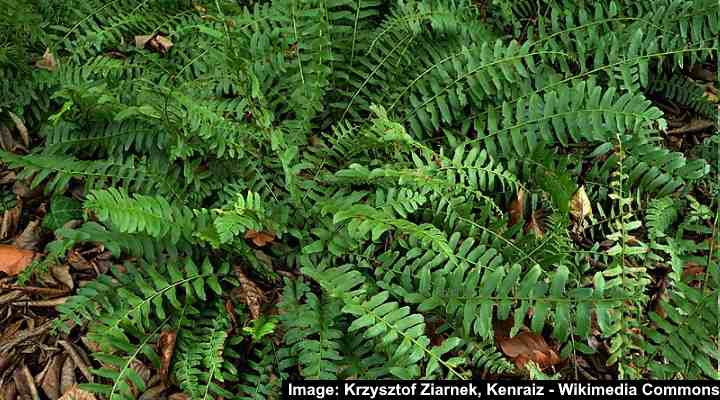
Christmas fern is a popular evergreen fern to plant in the understory of pine trees. The clump-forming fern is known for its dark green, leathery arching fronds that remain green throughout winter. Growing up to 2 ft. (0.6 m) tall, the shade-loving, pine-tolerant plants thrive in dry, well-drained, acidic soils.
Christmas ferns are ideal plants for a pine tree environment and woodland gardens. In addition to their low maintenance and evergreen foliage, they are also rabbit and deer-resistant. In time, they form a dense ground cover, providing lush green foliage under pine trees.
- USDA Planting Zone: 3 to 8
- Sun Exposure: Partial shade to full shade
- Mature Size: 1 to 2 feet (0.3 – 0.6 m) tall
- Growth Rate: Slow spreading
Japanese Painted Fern (Athyrium niponicum var. pictum)
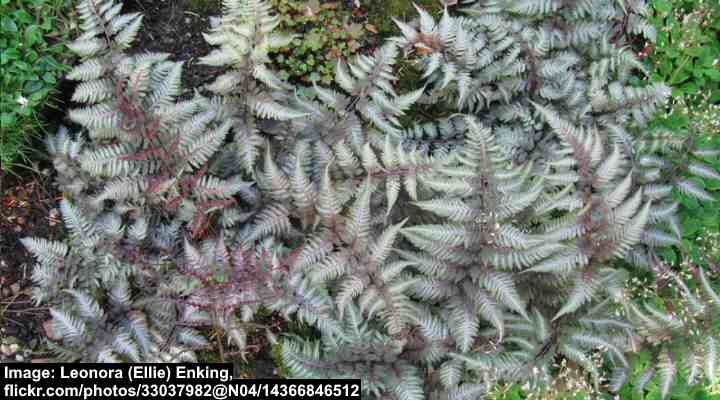
Japanese painted fern is a shade-loving plant that adds a touch of evergreen elegance to pine woodlands. The attractive slow-growing fern has unique silver-gray fronds with burgundy stems and midribs. Its foliage gives coniferous woodland floors a graceful texture and attractive ground cover.
Japanese painted ferns prefer partial shade and well-drained soil. They are tolerant of deer, rabbits, and full shade. Japanese painted ferns grow up to 18” (45 cm) tall and slowly spread over time, forming attractive clumps.
- USDA Planting Zone: 3 to 8
- Sun Exposure: Partial shade to full shade
- Mature Size: 12” to 18” (30 – 45 cm) tall
- Growth Rate: Slowly spreads over time
Marginal Wood Fern (Dryopteris marginalis)

Marginal wood fern is a hardy, shade-loving fern that thrives in the shade of pine trees. With its lacy, dark green fronds, it adds a touch of elegance to woodland gardens. This fern grows up to 2 ft. (0.6 m) tall, and its evergreen foliage provides winter interest to pine environments.
Marginal wood fern forms a mounding clump and grows slowly. It’s exceptionally drought-tolerant and requires minimal care once established. It also tolerates sandy, acidic soil in humid environments.
- USDA Planting Zone: 3 to 8
- Sun Exposure: Partial shade to full shade
- Mature Size: 1 to 2 ft. (0.3 – 0.6 m) tall
- Growth Rate: Slow to moderate
Common Oak Fern (Gymnocarpium dryopteris)
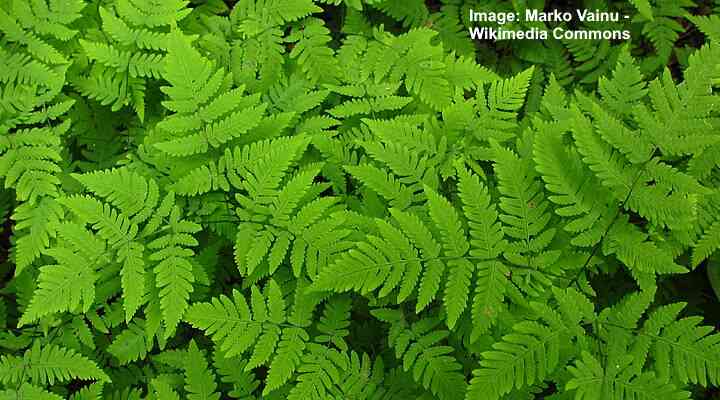
Common oak fern is a shade-loving understory fern that thrives growing around pine trees. This delicate fern has lacy, light green fronds 16” (40 cm) long. The leafy foliage adds texture and elegance to woodland gardens with well-drained sandy, gravely acidic soils.
Also called the northern oak fern or western oak fern, this leafy plant adds a touch of greenery to shady areas under pine trees. Common oak ferns are also deer-resistant and low-maintenance, making them a popular landscaping option for wooded gardens.
- USDA Planting Zone: 4 to 8
- Sun Exposure: Partial shade to full shade
- Mature Size: 6” to 12” (15 – 30 cm) tall
- Growth Rate: Slow spread
Lady Fern (Athyrium filix-femina)
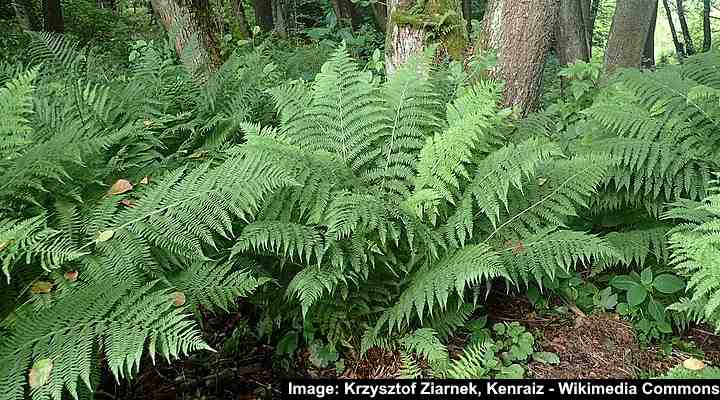
Lady fern is a beautiful, shade-tolerant fern that is a great landscaping option under pine trees. This fern variety is known for its delicate, lance-shaped lacy fronds with bipinnate leaves. The fast-growing fern helps fill bare patches between flowering shrubs or under pine trees. It naturalizes easily in well-drained soils.
Lady ferns can grow up to 3 feet (1 m) tall and spread rapidly through spores. These ferns are more tolerant of dry ground and shade than other varieties of ferns—ideal for growing at the base of pine trees. They are also resistant to deer and rabbits.
- USDA Planting Zone: 4 to 9
- Sun Exposure: Partial shade to full shade
- Mature Size: 1 to 3 feet (0.3 – 0.9 m) tall
- Growth Rate: Rapidly spreads
Landscaping Bushes That Grow Under Pine Trees
Planting landscaping bushes under pine trees enhances the garden’s aesthetic. Shade-loving shrubs that tolerate poor soil provide year-round interest, texture, and color. They create a balanced and visually appealing landscape.
Encore Azalea Shrubs (Rhododendron ssp.)
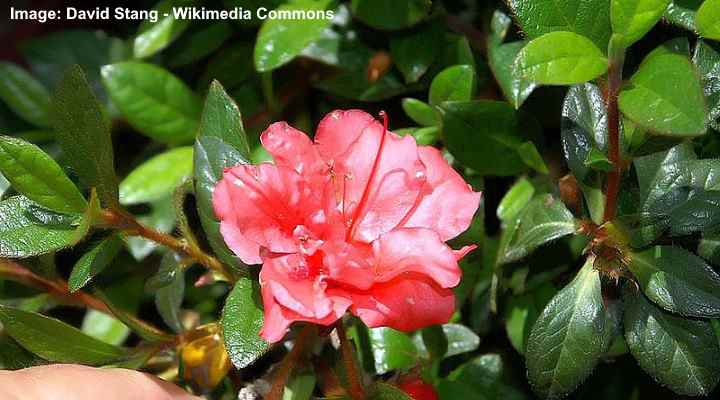
Encore azalea ‘Autumn Princess’
Encore azalea shrubs are a popular choice for planting around the drip line of pine trees. These reblooming evergreen shrubs are known for their vibrant and long-lasting trumpet-shaped blooms. The shrubs bloom in spring and then again in late summer or early fall, providing continuous color throughout the season.
Encore azaleas are ideal for landscaping pine environments due to their dense, rounded habit. The small bushy plants also thrive in acidic soil and partial shade, conditions common in pine woodlands.
- USDA Planting Zone: 6 to 10
- Sun Exposure: Full sun to partial shade
- Blooming Season: Spring and late summer through early fall
- Mature Size: 2 to 3 ft. (0.6 – 1 m) tall and wide
- Growth Rate: Moderate
Hydrangeas

Hydrangea shrubs are popular landscaping bushy plants that can grow under pine trees because they thrive in acidic soil. The flowering deciduous shrubs bloom throughout summer with large, showy flower clusters of blue, pink or purple blossoms. Hydrangeas prefer partial shade or dappled sunlight. Therefore, they will grow best at the edges of pine tree canopies.
Hydrangea flower color depends on the soil’s pH levels. Therefore, mophead, lacecap, smooth, and panicle hydrangeas growing near pine trees typically have bluish flowers. Because hydrangeas typically require moisture, mulching around their roots and adding compost can help them thrive.
- USDA Planting Zone: 3 to 8
- Sun Exposure: Full sun, dappled sunlight, or partial shade
- Blooming Season: Summer to fall
- Mature Size: 4 to 5 ft. (1.2 – 1.4 m) tall and wide
- Growth Rate: Moderate to fast, depending on the variety and growing conditions
Landscaping Perennial Plants For Under Pine Trees
Planting long-blooming perennial plants under pine trees adds beauty and stability to the landscape. They thrive in shaded environments and dry soils, meaning less maintenance. Perennial plants for pine environments enhance the overall garden appeal.
Zigzag Goldenrod (Solidago flexicaulis)

Zigzag goldenrod is a yellow-flowering perennial herbaceous plant that grows well around pine trees. The flowering perennial plant is known for its clusters of bright yellow, pretty flowers and lance-shaped leaves growing on zigzag stems. Thriving in the shade of pine trees, the erect perennial plant tolerates acidic, drought-prone soils.
Zigzag goldenrod grows up to 3 ft. (1 m) tall and adds a pop of golden yellow colors to densely shaded woodlands. It blooms in late summer through early fall and is adapted to the dry conditions commonly found under pine trees. It also attracts pollinators to woodland areas, helping to enhance biodiversity.
- USDA Planting Zone: 2 to 9
- Sun Exposure: Full sun, partial shade, and full shade
- Blooming Season: Late summer to early fall
- Mature Size: 2 to 3 ft. (0.6 – 1 m) tall
- Growth Rate: A medium growth rate, spreading through rhizomes
Barrenwort (Epimedium spp.)

In the picture: Red barrenwort (Epimedium × rubrum)
Barrenwort is ideal for growing under pine trees because it tolerates dry, shady conditions. This versatile, hardy plant has heart-shaped leaves that turn bronze, red, and yellow shades in the fall. Its flowers are shaped like a bishop’s hat and bloom in early spring in white, yellow, pink, and purple colors.
Barrenwort thrives in the shade, making it ideal for adding a pop of color below pine trees. The low-growing perennial forms a dense ground cover in slightly acidic or neutral soil. Barrenwort is also deer-resistant and easy to grow in challenging conditions. It’s a great choice for adding beauty to pine woodlands with minimal effort.
- USDA Planting Zone: 6 and 7
- Sun Exposure: Partial shade to full shade
- Blooming Season: Early spring
- Mature Size: 0.5 to 1.5 ft. (0.15 – 0.45 m) tall and up to 2 ft. (0.6 m) wide
- Growth Rate: Slow growth rate, forming a dense ground cover over time
Wild Geranium (Geranium maculatum)

Wild geranium—also called cranesbill—is a versatile plant that thrives in conditions where pine trees grow. This native wildflower is an ideal plant to grow under trees because it performs well in light shade, slightly dry, loamy soil. It blooms in spring and summer with small clusters of saucer-shaped pink, blue, red, or white flowers, each with five petals.
Wild geraniums have deeply lobed leaves with toothed margins. The attractive parsley-like leaves and spring flowers add texture and color to areas around pine trees. Additionally, the ground-hugging flowering perennial tolerates deer and rabbit damage. The fragrant flowers also attract pollinators like bees and butterflies.
Wild geranium has a spreading growth habit, forming dense clumps over time.
- USDA Planting Zone: 3 to 11
- Sun Exposure: Partial sunlight to light shade
- Blooming Season: Late spring throughout summer
- Mature Size: 1 to 2 feet (0.3 – 0.6 m) tall and wide
- Growth Rate: Rapid growth rate, forming dense mounding clumps
Hosta (Hosta spp.)
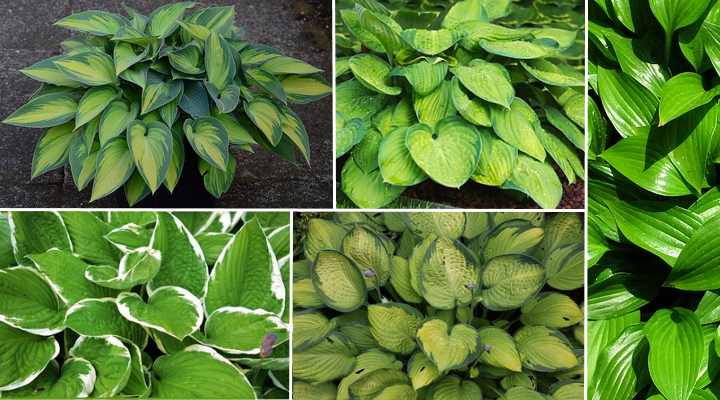
Hosta plants are well-suited to growing around pine trees because they tolerate acidic soil and shady conditions. Hostas provide plenty of attractive foliage to woodland understories. The shade-tolerant perennials have large, deep green, oval, pointed leaves growing in attractive mounds. Giving hostas occasional fertilization and regular watering is necessary to thrive under pines.
Hostas grow in most zones in the US and are useful for covering bare ground under trees. They typically don’t grow taller than two feet (0.6 m) tall. Hostas also have clusters of small white flowers growing on tall spikes above the foliage. One of the advantages of hostas is that they will grow in deep shade where other plants struggle.
- USDA Planting Zone: 3 to 8
- Sun Exposure: Partial shade to full shade
- Blooming Season: Summer
- Mature Size: 1 to 2 ft. (0.3 – 0.6 m) tall and up to 4 ft. (1.2 m) wide
- Growth Rate: Moderate to fast
Lily of the Valley (Convallaria majalis)
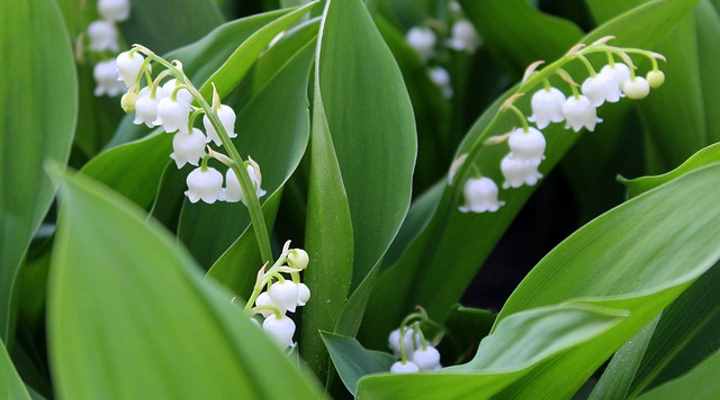
Lily of the valley is a beautiful white-flowering perennial that thrives in the shade of pine trees. The understory plant is recognized by its white bell-shaped flowers nodding on arching stems with a sweet fragrance. These contract with the attractive lance-shaped green leaves.
Lily of the valley is a great choice for underplanting near pine trees. The spreading plant adds a pop of bright color, powerful floral aromas, and lush foliage. They also complement other shade-tolerant plants like hostas and ferns in woodland gardens. The plants are easy to grow but may need extra watering when growing under pine trees as they require moist soil.
- USDA Planting Zone: 2 to 7
- Sun Exposure: Partial shade to full shade
- Blooming Season: Mid to late spring
- Mature Size: 6” to 12” (15 – 30 cm) tall and wide
- Growth Rate: Spreads rapidly and forms colonies over time
White Trillium (Trillium grandiflorum)
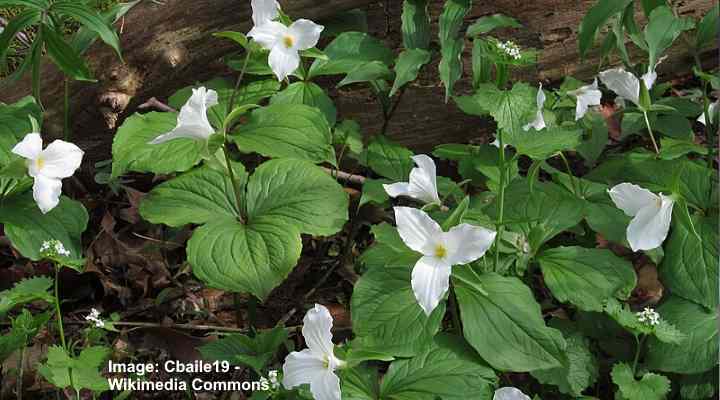
White trillium is a stunning perennial plant that thrives in the shade of pine trees. Blooming in early spring, it’s a woodland wildflower known for its large, white, three-petaled flowers 4” (10 cm) across. The attractive blossoms contrast nicely with the whorls of broadly ovate leaves.
White trillium thrives in well-drained, acidic soil and partial to full shade in pine environments. The clump-forming erect perennial grows up to 2 ft. (0.6 m) tall. The lush foliage and brilliant white flowers create a serene and elegant atmosphere in a shaded landscape around pine trees.
- USDA Planting Zone: 4 to 8
- Sun Exposure: Partial shade to full shade
- Blooming Season: Mid-spring to early summer
- Mature Size: 1 to 2 ft. (0.3 – 0.6 m) tall and 1 ft. (0.3 m) wide
- Growth Rate: Slowly spreads over time
Fumewort (Corydalis lutea)

Fumewort is a shade-loving plant with yellow flowers blooming from spring through fall. Well-suited to pine environments, fumewort thrives in shade and well-drained soils. The attractive perennial is known for its delicate, fern-like foliage and tubular, bright yellow flower clusters. Easy to grow, the plant thrives on neglect and spreads easily.
Fumewort plants add a splash of bright yellow colors to shaded areas around pine trees. The long-blooming plant grows up to 2 ft. (0.6 m) tall. It’s also an excellent choice for understory ground cover in woodlands and shaded landscapes to attract butterflies and bees.
- USDA Planting Zone: 5 to 8
- Sun Exposure: Partial shade to full shade
- Blooming Season: Late spring to early summer
- Mature Size: 1 to 2 ft. (0.3 – 0.6 cm) tall
- Growth Rate: Spreads quickly through self-seeding
Woodland Sunflower (Helianthus divaricatus)

Woodland sunflower is a beautiful yellow-flowering perennial plant that brightens shaded areas under pine trees. The showy plant is known for its bright yellow, daisy-like, or star-shaped flowers, each with eight to 15 rays. These yellow flowers contrast with slender lanceolate leaves growing on smooth stems. Woodland sunflower blooms in late summer to early fall.
Woodland sunflower is a low-maintenance plant that is easy to grow in most dry, well-drained soil types. The easy-care flowers add color to drought-prone landscapes and areas that get little rainfall—like under the canopy of pine trees. Growing up to 6 ft. (1.8) tall, the plant adds height and vertical interest to woodland landscapes.
- USDA Planting Zone: 3 to 8
- Sun Exposure: Partial shade
- Blooming Season: Early summer through fall
- Mature Size: 2 to 6 ft. (0.6 – 1.8 m) tall
- Growth Rate: Medium growth rate, spreading through rhizomes
Great Solomon’s Seal (Polygonatum biflorum)

Great Solomon’s seal is a beautiful flowering perennial with greenish-white blooms that perform well under pine trees. This understory pine-friendly plant features clusters of nodding tubular flowers, oblong leaves, and deep purple berries in the fall. It thrives in shaded landscapes and dry to moist soils.
Great Solomon’s seal grows up to 5 ft. (1.5 m) tall. It is easy to grow in cool, lightly shaded, or full-shade woodland landscapes. Its tolerance for shade and acidic soils also makes it a good choice for pine environments. The rhizomatous perennial spreads slowly through underground roots.
- USDA Planting Zone: 3 to 7
- Sun Exposure: Partial shade to full shade
- Blooming Season: Late spring to early summer
- Mature Size: 4 to 5 ft. (1.2 – 1.5 m) tall and wide
- Growth Rate: Slowly spreads through rhizomes
Landscaping Ground Cover Plants Under Pine Trees
Planting ground cover plants under pine trees prevents erosion, suppresses weeds, and adds a carpet of greenery. Shade-tolerant, ground-hugging plants enhance a garden’s appearance where pine trees are growing.
Japanese Forest Grass (Hakonechloa spp.)

Hakonechloa macra ‘All Gold’
Also called Hakone grass, Japanese forest grass is a beautiful ornamental grass for planting around pine trees. This grass is known for its mound of cascading, arching foliage of bright green leaves. In the fall, the leaves turn shades of orange, red, and gold. These features add texture, movement, and color to pine woodlands.
Japanese forest grass is slow-growing and prefers sandy, well-drained soil. Because it requires consistently moist conditions, it’s best to grow Hakone grass at the edge of a pine woodland so it benefits from rainfall. Unlike most ornamental grasses, its tolerance for full shade makes it an important landscaping plant for shady spots and poor soils.
- USDA Planting Zone: 5 to 9
- Sun Exposure: Full sun, partial shade, full shade
- Mature Size: 1 to 2 ft. (0.3 – 0.6 m) tall and wide
- Growth Rate: Slow spreading growth rate, forming dense clumps over time
Wintergreen (Gaultheria procumbens)
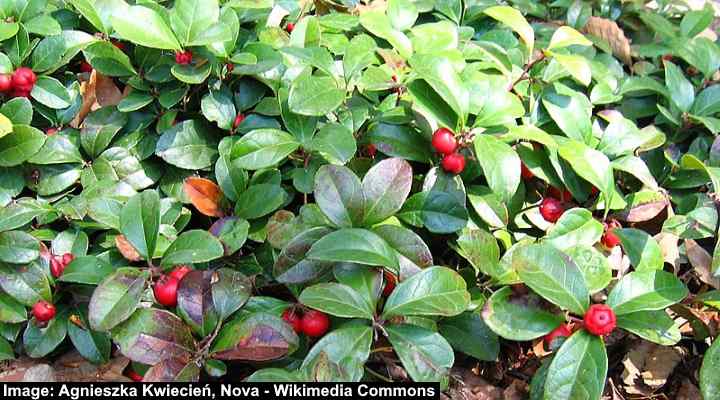
Wintergreen is a low-growing evergreen plant adapted to the acidic environments of pine forests. Identifying features of the low-growing, spreading shrub are its rounded, leathery leaves, pinkish, bell-shaped flowers, and glossy red berries. Wintergreen plants prefer acidic, well-drained soil and shade, making them ideal for planting under pine trees.
In addition to its attractive foliage and berries, wintergreen has a pleasant, minty fragrance when its leaves are crushed. This makes it a popular choice for evergreen ground cover in woodland gardens or underplanting large shrubs.
- USDA Planting Zone: 3 to 9
- Sun Exposure: Partial shade to full shade
- Blooming Season: Late spring to early summer
- Mature Size: 3” to 6” (7.5 – 15 cm) tall
- Growth Rate: Slow spreading, ground cover plant
Sweet Woodruff (Galium odoratum)
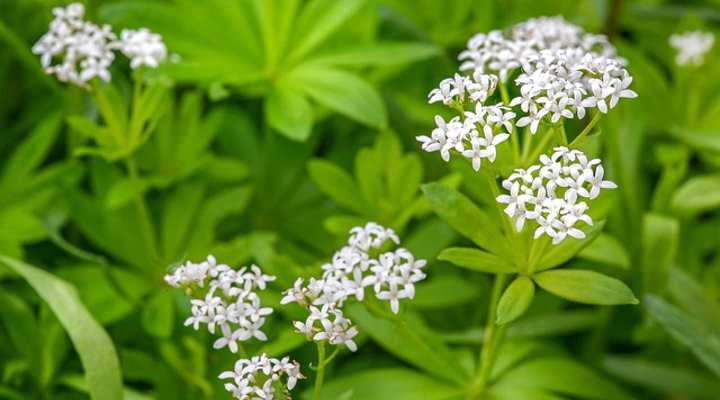
Sweet woodruff is a fragrant ground cover plant with white flowers that thrives in the shade of pine trees. Blooming in spring and summer, the ground cover plant features star-shaped white flowers with four petals. These contrast with whorls of soft-emerald-green, lance-shaped leaves. It’s ideal for covering bare ground around pine trees.
Sweet woodruff is easy to grow, quickly forming a dense mat of foliage. The undemanding shade-friendly plant suppresses weeds and creates a natural carpet in shady areas. It prefers slightly acidic soil and tolerates dry coil conditions, making it suitable for pine tree settings.
- USDA Planting Zone: 4 to 8
- Sun Exposure: Partial shade to full shade
- Blooming Season: Late spring and early summer
- Mature Size: 5” to 6” (13 – 15 cm) tall and 12” (30 cm) wide
- Growth Rate: Moderate growth rate, forming a dense ground cover over time and can become invasive
Kinnikinnick (Arctostaphylos uva-ursi)
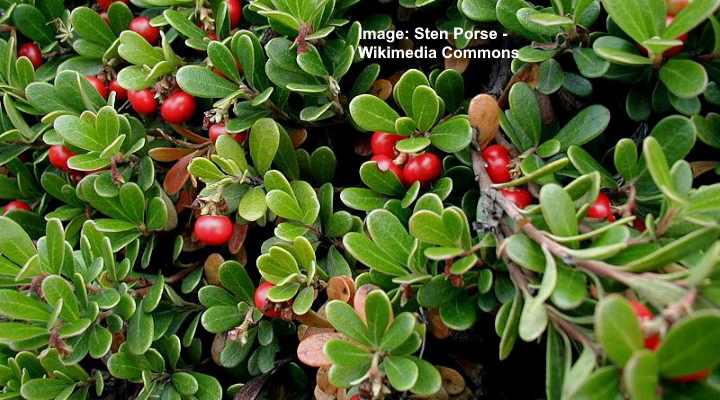
Kinnikinnick, or bearberry, is a tough and low-growing evergreen ground cover plant suitable for growing around pine trees. The hardy plant thrives in dry, poor, nutrient-deficient, acidic soil in full sun to partial shade. Kinnikinnick is identified by its small, leathery dark green leaves, urn-shaped white flowers, and red berries in the fall.
Kinnikinnick is a great choice for covering the bare ground between pine trees. Its dense, spreading growth habit and dainty white flowers add visual interest to pine woodlands. Also, the native plant is salt and drought-tolerant, making it suitable for growing near pine trees in coastal landscapes.
- USDA Planting Zone: 2 to 6
- Sun Exposure: Full sun to partial shade
- Blooming Season: Spring
- Mature Size: 6” to 12” (15 – 30 cm) tall and up to 6 ft. (1.8 m) wide
- Growth Rate: Slow to moderate growth rate, forming a dense ground cover over time
Creeping Phlox (Phlox subulata)

Creeping phlox is a mat-forming ground cover plant that adds color and vibrancy to shady areas around pine trees. This low, creeping evergreen plant is covered in a profusion of small, five-petaled flowers. The flowers emerge in mid-spring and bloom for four weeks. These stunning blossoms can be pink, purple, lavender or white.
Creeping phlox thrives in the same environment where pine trees grow. They perform best in well-drained, slightly acidic sandy soil. Once established, phlox tolerates partial shade to full sun and withstands drought periods. This hardy ground cover plant fills bare spots with lush foliage and color under pine trees.
- USDA Planting Zone: 3 to 9
- Sun Exposure: Full sun to partial shade
- Blooming Season: Mid to late spring
- Mature Size: 4” to 6” (10 – 15 cm) tall and up to 2 ft. (0.6 m) wide
- Growth Rate: Rapid spread, forming a blanket-like floral display
Columbine (Aquilegia)

Texas gold columbine (Aquilegia chrysantha ‘Hinckleyana’)
Columbine is a versatile plant that can thrive in the shade and dappled sunlight of pine trees. This perennial ground-spreading plant has unique, tubular flowers blooming in early spring in red, pink, yellow, and purple shades. The delicate flowers contrast beautifully with the fern-like foliage consisting of deeply lobed leaves.
Columbine thrives in well-drained, sandy soil and tolerates periods of drought. The pine-friendly plant grows up to 3 ft. (1 m) tall. It is also deer-resistant and attracts hummingbirds and butterflies with their nectar-rich flowers. Columbines self-seed and naturalize in the garden, creating a lovely, low-maintenance display in partially shaded landscapes.
- USDA Planting Zone: 3 to 8
- Sun Exposure: Partial shade to full shade
- Blooming Season: Mid-spring to mid-summer
- Mature Size: 1 to 3 ft. (0.3 – 0.9 m) tall and 1.6 ft. (0.5 m) wide
- Growth Rate: Moderate growth rate, forming clumps over time and spread by self-seeding
Coral Bells (Heuchera)

Coral bells plants are popular for growing around pine trees due to their tolerance to shade and dry conditions. These versatile clump-forming plants are known for their attractive foliage in various colors—from bright greens to deep purples. They produce slender, airy spikes of small, bell-shaped flowers in late spring or early summer.
Coral bells are perfect for adding a touch of colored foliage to shaded areas around pine trees. The attractive, easy-grow evergreen plants thrive in dry shade and are salt and drought-tolerant. They spread easily in full sun to deep shade landscapes, not growing more than one foot (30 cm) tall.
- USDA Planting Zone: 4 to 9
- Sun Exposure: Full sun, dappled sunlight, partial shade, or full shade
- Blooming Season: Spring to summer
- Mature Size: 1 to 2 ft. (0.3 – 0.6 m) tall and wide
- Growth Rate: Moderate growth rate, forming clumps over time
Allegheny Spurge (Pachysandra procumbens)

Allegheny spurge is a low-growing ground cover plant that thrives in the woodland shade of pine trees. This shrubby, low-growing plant has blue-green toothed leaves, creating a dense carpet of foliage that turns golden bronze shades in the fall. In early spring, Allegheny spurge produces white, fragrant flower spikes that enhance the beauty of pine woodlands.
Allegheny spurge is a ground cover plant not growing more than a foot (30 cm) tall. It is suitable for pine tree planting because it thrives in full shade and acidic, well-drained soils. It’s also tolerant of drought, deer, and most pests. These growing factors make Allegheny spurge a valuable carpet-forming plant for growing around pine trees.
- USDA Planting Zone: 5 to 9
- Sun Exposure: Partial shade to heavy shade
- Blooming Season: Early to late spring
- Mature Size: 6” to 12” (15 – 30 cm) tall and up to 24” (60 cm) wide
- Growth Rate: Slow to medium growth rate, forming a dense ground cover over time
Spotted Deadnettle (Lamium maculatum)

Spotted deadnettle is a versatile ground cover plant with purple-pink flowers well-suited for pine tree environments. This low-growing perennial blooms in spring through fall and thrives in full shade and well-drained soils. Its long-blooming purple tubular flowers appear in large whorls contrasting with the heart-shaped, serrated leaves.
Spotted deadnettle is an excellent choice for adding color and texture to shaded areas around pine trees. It is also deer-resistant and easy to grow in various soil types. The plant’s spreading nature quickly forms dense ground cover under shrubs, perennials, or coniferous trees. Additionally, its nectar-rich flowers attract pollinators like bees and butterflies.
- USDA Planting Zone: 4 to 8
- Sun Exposure: Partial shade to full shade
- Blooming Season: Late spring through fall
- Mature Size: 4” to 8” (10 – 20 cm) tall and up to 10” (25 cm) wide
- Growth Rate: Fast growth rate, spreading rapidly through runners
Cast Iron (Aspidistra elatior)
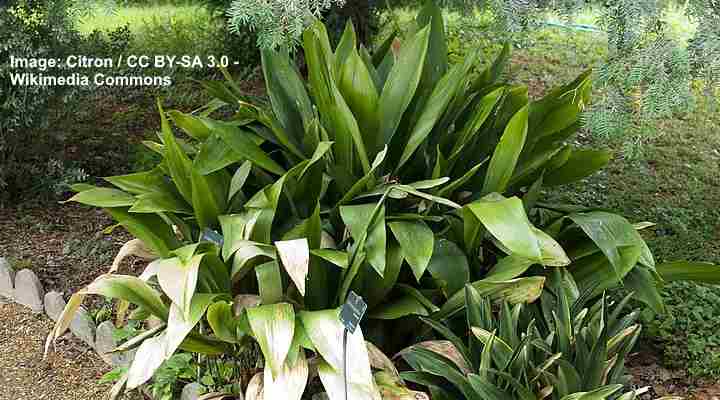
The cast iron plant is an ideal ground cover for growing under pine trees because it can thrive in the dry shade beneath them. Its tolerance for acidic soil enables it to adapt to the specific pH levels commonly found in the vicinity of pine trees.
The dark green leaves of the cast iron plant create an attractive contrast to the pine needles, enhancing the visual appeal of the area. Its slow growth rate and minimal maintenance needs make it an excellent choice for gardeners seeking a hassle-free, visually appealing plant for shaded and dry areas under pine trees.
True to its name, the cast iron plant is incredibly resilient, surviving both cold snaps and hot, humid conditions. This evergreen perennial also thrives as an indoor houseplant, making it suitable for rooms with limited natural light.
- USDA Planting Zone: 7 to 11, although it can sometimes tolerate zones 6 with proper protection.
- Sun Exposure: Thrives in shaded environments and prefers indirect or filtered light.
- Blooming Season: While it can produce small, inconspicuous purple to maroon flowers close to the ground, it rarely blooms when grown indoors or in shaded areas.
- Mature Size: 2 to 3 feet (60 to 90 centimeters) and can spread to a similar width, forming a clumping, dense growth habit.
- Growth Rate: Known for its slow growth rate, the cast iron plant develops gradually over time, requiring minimal pruning or maintenance once established.
How Should You Design and Layout a Landscape Under Pine Trees?
When designing your pine tree landscape, create layers of planting for visual interest, placing taller plants at the back and shorter ones towards the front. Enhance aesthetics with mulch or decorative rocks and reduce competition with tree roots.
What Maintenance and Care Practices are Essential for a Healthy Pine Tree Landscape?
Regularly remove fallen pine needles and cones, and consider supplemental watering during dry periods. Prune lower branches for improved air circulation and to allow more light to reach understory plants.
Should You Leave Pine Needles on the Ground?
Yes, you can leave pine needles on the ground and use them as a mulch. Although pine needles are acidic, they lose their acidity as they decompose naturally. Therefore, you can leave them as mulch to suppress weeds, retain moisture, and enrich the soil with nutrients.
Can You Plant Grass Under Pine Trees?
Planting grass under pine trees can be challenging due to factors like shade, acidic soil, root competition, and moisture levels. While possible with shade-tolerant varieties, it may require extra care and maintenance. Consider alternative ground covers for under pine trees.
Related articles:
